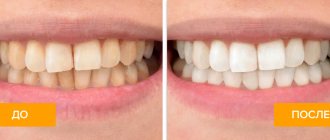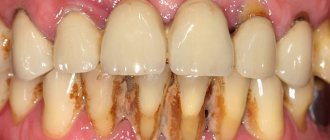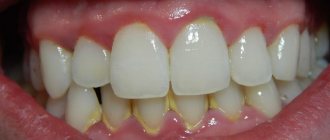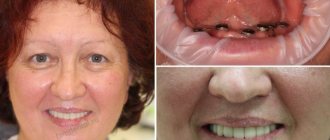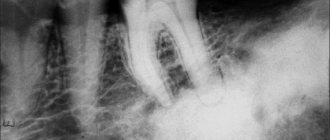Tartar in humans is a mineralized soft plaque that was not removed in a timely manner. Hard dental deposits are formed as a result of an increase in the mass of soft ones if they are not cleaned off. The hardening process occurs due to impregnation with mineral salts in saliva. As a rule, 10–16 hours from the moment of appearance are sufficient for partial mineralization of soft plaque, but the time may vary depending on the individual characteristics of each person.
Stones consist of organic (leukocytes, pathogenic bacteria, protein-polysaccharide components, epithelial cells from mucous membranes) and inorganic (calcium salts) components.
Types of Tartar
Tartars on teeth are classified according to where they are located:
- supragingival - they are visible to the naked eye during a routine examination. They look like dark or yellowish deposits above the gum level. This type of stone is easier to remove;
- subgingival - what this type of tartar looks like can only be determined by a doctor. This type of deposit is located under the gum, below its level, so it is impossible to see it. However, there are indirect signs of the formation of such stones: redness, swelling or cyanosis of the gums, bleeding, and possible outflow of pus from the periodontal pocket.
The second type of hard deposits is more dangerous because it is indirect evidence of periodontitis and periodontal disease. The stone is formed due to the destruction of the attachment of the gum to the surface of the tooth, its detachment. The next stage may be a structural change in the tissues that hold the tooth, loosening and its loss.
How to get rid of dental plaque
Methods for removing dental plaque refer to professional hygiene. The ideal result can be achieved by combining different methods of brushing your teeth.
First, hard stone is “beaten” from the surface of the teeth using an ultrasonic attachment or special hand tools to remove dental plaque.
Then the interdental spaces are cleaned with a water-soda jet, which is supplied from an Air Flow apparatus, or with strips - thin abrasive strips of metal or plastic. The remaining plaque is polished off with polishing discs and rubber bands, then the teeth are brought to a shine with a brush and paste. The final stage of cleaning dental plaque is surface fluoridation to prevent caries and reduce tooth sensitivity.
If you have any questions, come to the DentaBravo clinic!
Diagnostic features
If supragingival stones are easy to see on your own, then those located under the gum can only be seen with the help of special tools from a dentist. Diagnosis is carried out as follows: the doctor immerses the probe into the periodontal pocket, which makes it possible to verify the presence of hard deposits, as well as determine the depth of the pocket. This will allow you to choose how to remove the stones.
It is possible to diagnose supragingival calculus even in the early stages of its appearance. There are special tablets on sale that, when bitten, stain areas of the tooth with stone.
Mechanism of formation of tartar
The causes of tartar are as follows: after eating food, particles remain in the mouth. They act as a favorable environment for the proliferation of pathogenic bacteria. They give greater preference to easily digestible carbohydrates: particles of sweet food, baked goods. Experts have found that even one day of lack of hygiene doubles the amount of bacterial plaque in the mouth.
Nutrients are used by microorganisms for more than just reproduction. They also secrete special enzymes - enzymes, which allow them to firmly attach to the surface of the tooth enamel. Lack of hygiene leads to the fact that individual pinpoint colonies quickly merge into one “plaque”, forming an impressive mass of plaque. Before it begins to mineralize, it can be easily brushed off with a toothbrush.
With the gradual mineralization of soft deposits, stone formation occurs. Calcification occurs as follows: calcium salts, which are part of saliva, settle on the soft plaque. Mineralization is accompanied by the process of layering of new and new colonies of bacteria, which leads to an increase in the volume of solid deposits.
The mechanism of tartar formation is accompanied by processes such as the release of toxic substances and inflammatory mediators by plaque. This becomes the cause of inflammatory processes in soft tissues. Symptoms of this complication are:
- bleeding of the gums - due to mechanical stress, and in severe cases, spontaneous;
- redness, cyanosis, swelling of the gums;
- soreness, itching;
- the appearance of pus in periodontal pockets;
- mobility of individual teeth.
Inflammation contributes to an even greater increase in the number of bacteria. In the place where the gums adhere to the surface of the tooth there is a periodontal groove, into which liquid with salts and proteins is produced from the gums. This leads to the growth of bacterial colonies. With inflammation, this fluid becomes larger, resulting in an environment for reproduction that is even more favorable for microorganisms. Calcification occurs even faster.
Causes of tartar
So, we have figured out the mechanism for the appearance of solid deposits. What causes tartar and what contributes to its rapid formation? There are several factors:
- Ignoring hygiene, improper brushing of teeth. An increase in the volume of bacterial plaque leads to rapid mineralization and proliferation of the stone;
- consumption of carbohydrates (sweets, baked goods), preference for soft foods (lack of natural mechanical cleaning with solid foods);
- changes in the composition of saliva, its acidity or increased salivation as a result of metabolic disorders lead to rapid saturation of soft deposits with calcium salts;
- internal diseases, inflammatory, infectious, which causes a large number of pathogenic bacteria;
- rough surface of the teeth - “simplifies” the formation of soft and hard plaque;
- bite defects, which makes it impossible to properly clean some areas (for example, when teeth are crowded);
- taking certain medications that help change the composition of saliva.
The causes of tartar formation can be combined with each other. When visiting a dentist, it is important to find out about them in order to select effective methods of prevention.
Treatment
There are supragingival and subgingival tartar. The only treatment for both types is surgical removal. There are several types of such intervention:
- Laser. Equipment for such a procedure is expensive, so not every clinic has it. The principle of operation is crushing tartar and completely cleansing the enamel.
- Ultrasound. A completely non-traumatic method - during the procedure, the device attachment does not touch the tooth being treated. The ultrasonic cleaning method has absolute contraindications – the presence of a pacemaker. If the patient has problems with the heart and blood vessels, you need to warn the doctor about this. If the enamel is highly sensitive, tartar is removed with local anesthesia.
- Air Flow cleaning. Typically used as a final procedure after laser or ultrasonic cleaning. During this process, the remaining hard deposits are removed. The teeth are slightly whitened and the enamel is polished. Air Flow cleaning can be used as a stand-alone product only to remove very small and not completely hardened deposits.
What is the danger of tartar
Why is it so important to see a dentist? There are several unpleasant and dangerous consequences of tartar:
- halitosis or bad breath - as a result of the constant proliferation of pathogens;
- inflammation of the gums - gingivitis, periodontitis, as well as inflammation of the mucous membranes of the oral cavity (tongue, cheeks, lips, etc.) - microbes release toxins, inflammatory mediators, which causes the inflammatory process;
- spread of inflammation - in the absence of treatment, inflammation covers the tissues that hold the teeth in the jaw, the dentogingival attachment is disrupted, which leads to periodontitis and periodontal disease: loosening, the appearance of periodontal pockets with purulent contents, bone tissue atrophy, exposure of the necks of the teeth, and their loss;
- caries - soft and hard deposits contain microorganisms that provoke the appearance of caries. This occurs due to the release of hydrochloric acid, which destroys the enamel. The resulting defect is populated by pathogenic flora and a carious cavity is formed;
- general deterioration of condition and well-being - toxins released by bacteria are absorbed into the blood, which complicates the course of chronic diseases and can affect the functions of organs and systems.
That is why, regardless of the cause of tartar, it is important to seek professional dental help - removal.
How and why hard plaque forms on teeth
The oral mucosa is simply teeming with all kinds of bacteria, the quantities of which are in a certain ratio to each other. When the bacterial balance is disturbed, some microbes can multiply excessively and provoke all kinds of dental ailments. If for some reason teeth brushing has become poor and irregular, then a concentrate of 200 billion different bacteria will immediately react to this by the appearance of a mineralized film. It actively forms within 15 hours, and within a week it becomes quite noticeable plaque, which will turn into hard tartar in six months.
Tartar removal
Unlike soft deposits, hard deposits cannot be removed on your own: professional dental care will definitely be required. To do this, the doctor can use the following methods for removing tartar in dentistry:
Ultrasonic cleaning. This technique guarantees complete destruction and removal of tartar. It is used for supragingival and subgingival stones. The doctor uses an ultrasonic scaler - a special attachment connected to an ultrasound source machine. By directing the scaler at the tartar, it destroys it, and the supply of water allows you to remove it from the mouth and prevent overheating. Ultrasound does not have a harmful effect on dental tissue.
Air Flow method. The procedure is performed using a device that supplies a water-air mixture with abrasive particles. It is worth noting that this method is combined with ultrasound, but is not used as an independent method of stone removal - the abrasive may not be enough to destroy solid deposits. However, it perfectly fights soft plaque and serves as a way to prevent stones.
Mechanical removal. The doctor, using a special bur, mechanically separates the stone from the tooth and scrapes the enamel surface. This method does not allow impact on subgingival deposits; moreover, it is more traumatic than modern ones and can cause discomfort.
Laser removal. The doctor acts on hard deposits with a special attachment with laser radiation. He removes the stone layer by layer, crushing it. Removal from the oral cavity is carried out using water and a stream of air. The procedure does not cause discomfort and therefore does not require anesthesia.
Chemical removal. It consists of applying special products containing acids and alkalis to the surface of teeth covered with stone. They help soften the hard stone, and then the doctor removes it mechanically. The only disadvantage of this method is its inability to apply to subgingival calculus. This method is used less frequently because acids can damage the enamel and it is important to ensure there are no risks.
Removal of subgingival hard deposits can be performed surgically - using closed or open curettage operations. Such procedures consist of gaining access and mechanical removal of subgingival stone using curettes and special instruments. They are required for diagnosed periodontal disease and involve the simultaneous removal of granulations from periodontal pockets. Curettage is carried out under mandatory anesthesia, since the doctor’s manipulations can be quite painful. It is important to entrust this procedure to a professional, a periodontist.
Preventive actions
In addition to regularly brushing your teeth, follow these rules:
- Eat right. The diet should contain hard foods.
- After eating, eat a sweet and sour apple. Its juice will dissolve some deposits.
- Use floss and a special rinse after every meal.
Visit your dentist regularly. All of the listed preventive measures are relevant when there is a small amount of supragingival hard deposits. What is happening in the area of the roots of the teeth can only be seen on x-rays. As practice shows, in approximately 50% of cases, tartar is deposited under the gums. This means that only a doctor can remove it.
After the removal procedure
After removing hard deposits, the doctor must polish the teeth - plaque accumulates more slowly on a smooth surface. Also, to consolidate the effect and strengthen the enamel, a product containing fluoride can be applied - a solution, gel in drops or fluoride varnish.
It is important to find out the reasons for the formation of tartar in order to take the necessary preventive measures. If one of the factors is a disease or metabolic disorder, consultation with a specialized specialist and correction of the condition is recommended.
Common prevention methods include:
- professional teeth cleaning twice a year - it can be difficult to remove all the plaque that forms on your own, especially if we are talking about an incorrect bite or other structural features of the dental system. It is necessary to visit a hygienist once every 6 months, and for those who wear orthodontic appliances - once every 4-5 months;
- maintaining oral hygiene at home - brushing your teeth twice a day, flossing;
- compliance with certain measures outside the home - use a mouthwash after eating, do not forget about flossing;
- limiting the consumption of foods that contribute to the appearance of a large amount of plaque (tea, coffee, sweet, sticky foods, baked goods);
- choosing a brush with the optimal degree of bristle stiffness (it is better to consult a doctor);
- choosing a paste containing pyrophosphate (in consultation with your doctor) - this component suppresses the formation of tartar;
- preference for solid products as a method of mechanical cleaning of teeth.
Tartar - photo. Tartar - causes of formation. Stones on teeth: what causes them to appear. Supragingival and subgingival tartar – removal.
Table of contents
- What is tartar?
- Causes of tartar formation
- Forms of tartar
- What does the formation of tartar lead to?
- Prevention of tartar
- Preventative toothpastes
- Tartar removal
- How to remove tartar at home
- Description of clinic services and prices
What is tartar?
Tartar is a yellowish or brown layer of mineral hard deposits on the surface of teeth, formed by hardened plaque.
Normally, teeth are almost always present with dental plaque, which represents exfoliated epithelium and food debris. It's hard to notice. After each meal, new food remains, microbes and their metabolic products are added to it. With poor, irregular cleaning, soft and loose plaque, due to increased acidity, causes inflammation in the soft periodontal tissues - gingivitis. Gradually accumulating, with poor cleaning, the plaque hardens and turns into the colors of the products consumed. This causes people to dislike and want to whiten them. Tartar removal is important for oral hygiene because, in addition to being a cosmetic issue, it promotes further plaque accumulation and causes gum inflammation, gum recession and gum disease.
Causes of tartar formation
Anaerobic plaque bacteria produce acids as a byproduct of their metabolism. They create an acidic environment in the mouth, causing calcium to be lost from tooth enamel (demineralization). Calcium, phosphorus and other minerals from saliva are absorbed into plaque and harden. This hardened structure is tartar. Its main ingredient is calcium phosphate, a hard, insoluble material that adheres to tooth enamel.
Tartar roughens the surface of the teeth's crowns and roots, allowing even more bacteria and minerals to "stick" to existing tartar much more easily. The rough surface of tartar, combined with acids derived from bacteria and food debris, provides an ideal environment for further plaque accumulation and growth. Day after day, these repeated cycles of acid production, loss of calcium and calcium phosphates lead to the formation of new layers of tartar on the teeth. As the volume of tartar increases, the risk of space between the tooth wall and the gum increases, which contributes to the development of periodontitis.
The main proven cause of this phenomenon remains insufficient oral hygiene. Regular removal of soft and hardened plaque once every six months will ensure proper prevention of the development of periodontal problems.
Forms of tartar
- Supragingival calculus Supragingival calculus is the most common and less harmful type of plaque as it is easily detectable. But, increasing in volume, it “grows” under the gum, moving it away from the wall of the tooth. Such a movement is very dangerous, because can lead to disruption of the integrity of the ligaments that hold the tooth in the bone socket.
- Subgingival calculus on teeth The formation of calculus occurs below the level of the gums and is more dangerous, since food debris rushes into the formed pocket between the tooth and the gum, which is difficult to clean out from under the gums at home with the usual brushes and dental floss.
What does the formation of tartar lead to?
- Bacteria attach more easily to tooth enamel containing plaque or tartar than to the smooth surface of a tooth. When tartar forms below the gum line, it can lead to serious complications such as gum irritation and damage. At this point, the patient may experience bleeding gums, bad breath and pain when eating. If you do not pay attention to such manifestations of gingivitis and periodontitis, this can lead to the progression of the disease and an increase in symptoms. The roots of the teeth are exposed and the stability of the tooth is lost due to a violation of the attachment of the tooth in the bone socket.
- Removing plaque by brushing and flossing becomes increasingly difficult. Brushing and flossing become virtually impossible when tartar builds up on your teeth. Additionally, acids released by bacteria in the mouth affect tooth enamel, causing tooth decay, tooth loss, or jaw bone degradation.
- Tartar irritates the gum tissue and causes gum recession. Subgingival anaerobic bacteria, which survive without oxygen, are responsible for the development of periodontitis by causing damage to the gums and gingival fiber - which forms the connection between the gum and teeth
- The risk of developing caries and gum inflammation increases.
- Teeth appear unattractive due to stains caused by tartar. In addition to cosmetic problems associated with tartar buildup, such as brown or yellowish teeth, other dental diseases can occur. Against the background of gingivitis and periodontitis, it is difficult to heal postoperative wounds in the oral cavity, it is impossible to carry out orthodontic treatment, and there is a high risk of relapse of caries after its treatment in a “dirty” oral cavity.
Poor oral hygiene and infertility in men
A study has found a link between low sperm count, a cause of infertility in men, and poor oral hygiene. The study found that bacteria responsible for gum disease may also reside in the spermatic cord and affect sperm quality.
Prevention of tartar
- Proper and regular brushing and flossing are essential to reduce plaque and plaque buildup.
- Professional hygienic teeth cleaning by a dental hygienist should be carried out on a regular basis at least once every 6 months
- The use of toothpastes that prevent the formation of tartar, as well as other additional hygiene products, such as a tongue scraper, solutions and foams for irrigating the oral cavity after meals, monotuft brushes, brushes for cleaning interdental spaces, etc.
Remember that it is recommended to brush your teeth after every meal. Using dental floss helps clean the interdental spaces (often toothbrush hairs cannot get there). Chewing gum is also recommended for use, especially without a brush or floss.
Preventative toothpastes to slow down the formation of tartar
They are a special type of toothpaste that can help reduce the formation of new tartar, but they cannot remove existing tartar. They work by reducing the concentration of calcium phosphate in the mouth and absorbing it from plaque, preventing the formation of tartar.
Using them in some cases may cause increased sensitivity to hot and/or cold water/food in some teeth or irritation of the soft tissues of the oral cavity.
Tartar removal
Tartar is too hard on the surface of the teeth. It cannot be removed by regular brushing or flossing (regular plaque removal procedures). Only professional teeth cleaning by a dentist can remove it. Dentists use special instruments:
- Ultrasonic scalers are small thin instruments through which ultrasonic waves are applied to the surface of the tooth and break up hard plaque.
- Curettes and hand scalers are hand-held instruments for removing tartar above and below the gum and smoothing the root surface.
The removal of supragingival and subgingival stone is carried out. In the first case, the procedure does not take more than an hour to remove stone from all teeth. In the second case, a higher qualification of the doctor (periodontologist) is required - because In patients with periodontitis, stone deposition occurs in periodontal pockets.
After ultrasonic cleaning, it is recommended to grind the teeth with a special air-abrasive-water mixture AirFlow.
How to remove tartar at home
Plaque begins to form within 4-12 hours after brushing, so it is important to brush your teeth at least twice a day. Brushing and flossing regularly can help reduce plaque and tartar. Using the following home remedies can help prevent complications from tartar, including tooth decay, gum disease, and bad breath.
- Toothbrushes
- Classic electric brush
- Sonic toothbrushes
- Ultrasonic electric toothbrushes
Description of clinic services and prices
In our clinic you can carry out a full range of all hygienic procedures:
- Ultrasound removal of tartar – 150 rubles
- removal of dark plaque – 150 rubles
- removal of subgingival tartar – 170 rub.
- removal of dental plaque from an implant – 700 rubles.
- complex price for removing plaque and polishing with soda powder – 3,450 rubles.
- complex price for removing plaque and polishing with calcium – 4000 rubles.
{jlcommentspro}
